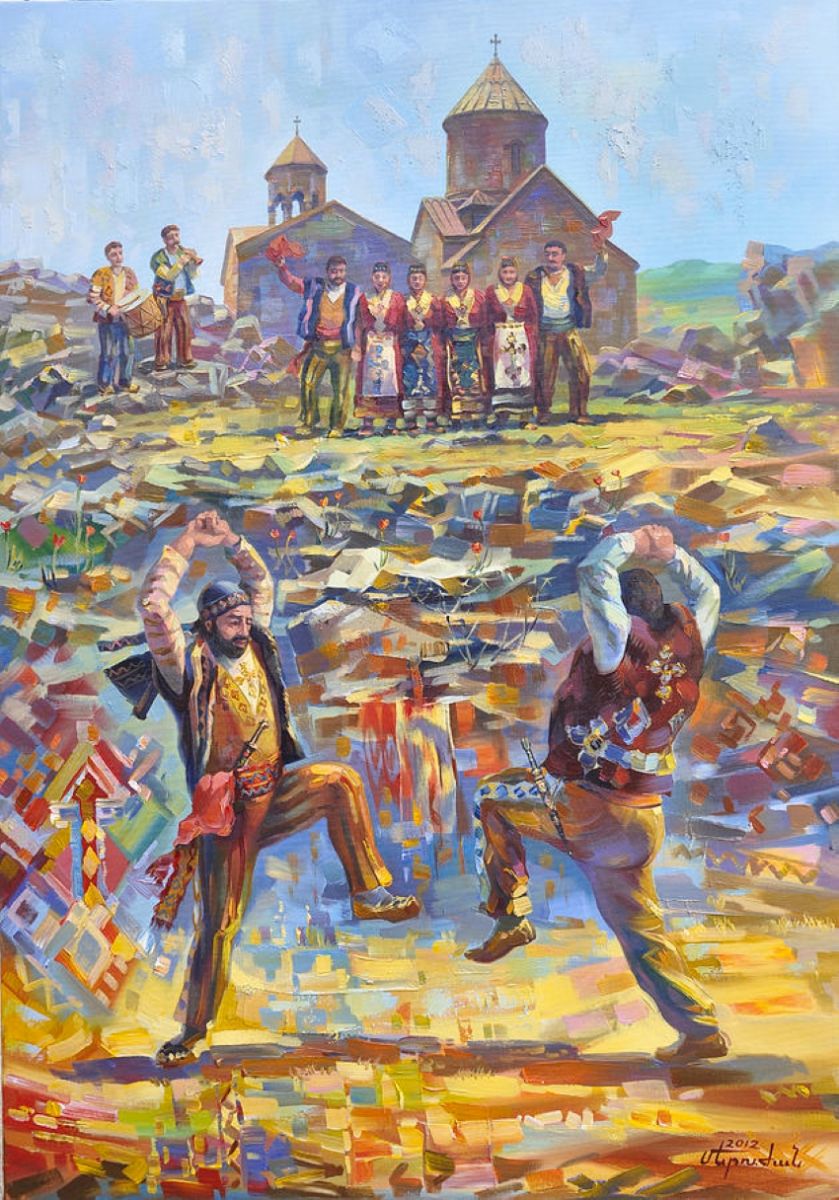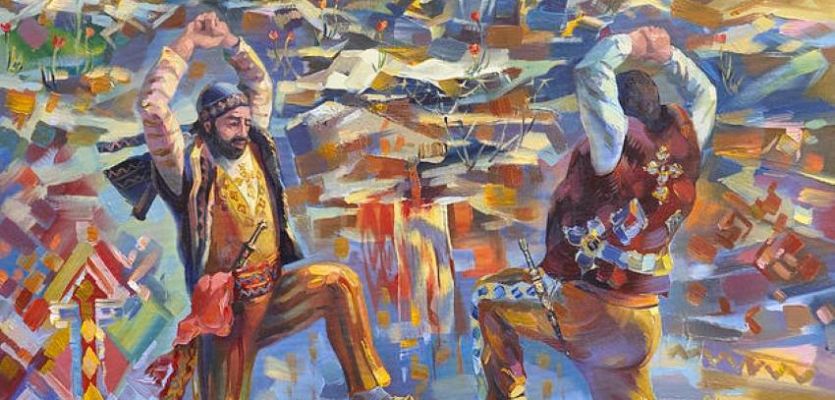Yarkhushta: The epic war dance you didn’t know you were missing
April 28, 2020
In the family of Armenian "clap dances" (ծափ-պարեր | tzap parer), Yarkhushta sits at the head of the table. In addition to its emotional, spiritual, and historical attributes, this folk and martial dance is a great all-body workout: cardio, squats, upper arm conditioning, and a whole slew of benefits that come with clapping! Just a few minutes of Yarkhushta-ing a day will have you toned like Vahagn, the Armenian Hercules. Read on to learn about this epic dance of the Armenian warriors!
Survival through movement
Barring “Ararat” and “duduk,” few Armenian cultural elements have been able to break into global vernacular. A couple of years ago, Kochari joined that exclusive list when UNESCO included the line dance in its ever-growing List of Intangible Cultural Heritage. But what if I told you that there is another dance that rivals it in antiquity, passion, and physicality?
Yarkhushta: Even the name sounds like a battle cry. Chances are, you’ve never heard of it. And, even if you have, you have no idea how to dance it.
Learning Yarkhushta was once a rite of passage for young men in Sasun—as important as toiling the fields or hunting for dinner. But, as a result of the genocide, the dance, like our people, had to flee from its native land. Most of the Talin region of today’s Republic of Armenia was settled by refugees from the Sasun Highlands. Though these villagers lost their ancestral lands, they never forgot their ancestral dances—especially the most formidable of them all: the Yarkhushta.
In the 1930s, a famous ethnographer named Srbuhi Lisitsian visited the Talin villages to study their dances; she included the Yarkhushta in her repertoire in Yerevan, which introduced the dance to a greater Armenian audience. Ever since, the Yarkhushta has become a staple at many celebrations in Armenia.
Growing up in my American suburb, we’d often watch tapes of our extended family’s weddings, anniversary parties, and birthdays in Armenia. These three hour-long home videos were mostly footage of strangers dancing; needless to say, not the most thrilling piece of cinematography.
Yet, every so often, everyone would evacuate the dance floor to make way for my grandfather and my mom’s cousin to engage in what looked like a coordinated fight. They’d move back and forth, swaying their arms in the air, gradually edging towards each other and striking hands, then squatting down and repeating. I’d never seen anything like it before. It wasn’t “beautiful” in the classical sense, but mesmerizing—like a martial art. I could not wait to try it out myself one day.
This summer, Papik (“grandpa”)—who grew up in one of these Sasuntsi villages—recollected his experience of learning our people’s sacred dance. “I would cry myself to sleep because my calloused hands would crack and bleed from all of the clapping.” His eyes seemed lost in the memories of his youth. With a sigh, he concluded, “No one dances like that anymore.”
Rules of the game
Last year, I wrote about Armenia’s favorite sport, kokh, a variant of wrestling. When danced in its true form, Yarkhushtahas many similarities to kokh. Both are brawls between two adversaries, yet rhythmic and coordinated in their aggression. They’re captivating not because of their grace or beauty but because of the unrestrained, raw passion that the duelers exude—passion that, I believed, was missing from our “naz” (graceful, feminine) dances. (Admittedly, I’ve always found our Armenian women’s dances too stiff and unnatural.)
 “Armenian Soul in Armenian Dance Yarkhushta" (oil on canvas, 43.3" x 31.5") by Meruzhan Khachatryan. You can purchase a print on various materials here. (Artist: Meruzhan Khachatryan)
“Armenian Soul in Armenian Dance Yarkhushta" (oil on canvas, 43.3" x 31.5") by Meruzhan Khachatryan. You can purchase a print on various materials here. (Artist: Meruzhan Khachatryan)
In the Sasuntsi dialect, one does not usually say, “let’s dance Yarkhushta!" Instead, the common refrain is “let’s play Yarkhushta.” The dance—like the battle scene it appears to recreate—is a game between two partners, and though there are “rules,” so much creativity and ingenuity goes into making a great “player.”
To the untrained eye, the clap-sway-hop-jump motions may appear like cool—if not, slightly aggressive—dance movements, but the more you study them, the more technical they seem. One-handed claps indicate which partner is “dominating” that “round”, though most dancers today choose to strike with only both hands in unison; the dance must always end this way—by locking hands with both arms extended, as though building a fort—indicating that there is no winner or loser in this battle.
I once wrote that I become a raging Armenian nationalist only when I dance our folk dances. That was partially true. I become a raging Armenian nationalist only when I play the Yarkhushta.
Akunkner (ակունքներ | origins)
You would be shocked to hear that, as a female, there are very few opportunities to engage in this warrior dance. But was Yarkhushta strictly limited to men in antiquity? We don’t know for certain, but it would be ironic if a male-only dance was all but resurrected by a single woman. Today, women engage in the martial dance, though not in the same numbers as men.
Theories run abound about the dance’s origins. Some say that the word comes from “yar” meaning “my love” and “khusht” meaning “small dagger” in Persian. Others posit that it means “friend of the weapon.” Some theorize that the dance is an imitation of rams budding horns, others say it’s bulls. Others yet believe that the flailing arms resemble eagles soaring in the sky and colliding. Social scientist, Charles Darwin, concluded that birds danced to attract their mates. Perhaps this was a way for men to elicit attention from the opposite sex? So much of the dance’s history is unknown, but we do know that it is very, very old.
Sources say that the dance has its origins in the medieval period, leading us to believe that it is at least 1,000 years old—possibly even older, predating our Christian identity. And ethnographers say that it one of just a few Armenian dances to have undergone little change throughout the centuries. How remarkable is that?
In ancient times, the dance was accompanied by a song with the repetition of “Tosilbano, tosilban.” No one knows the meaning of these words, but it was likely a war cry. Today, the dance is accompanied by a dhol (drum) and a double zurna, one for the melody and the other as a steady beat. Musicologists say that this combination heightens euphoria.
It’s no surprise, then, that our greatest fedayis (Armenian guerrilla fighters) engaged in the war dance prior to combat. Before experts studied the emotional effects of tones, harmonies, rhythms, and melodies, our ancestors had figured it out on their own—many moons ago!
But why should we learn it today?
Our ancient people believed that skilled dancers made for great warriors. And they were not wrong. But the association of war with dance is not unique to the Armenian Highlands. A whole category of war dances exists throughout many different cultures (especially in the Middle East/North Africa region), with perhaps the most famous example being the Maori Haka. In the Disney film, “Mulan,” there is a scene where the Chinese army breaks out into dance during a training session. It seems like a fantasy concocted for children, but the combination was probably more realistic than we gave it credit for.
Yarkhushta is Armenia’s contribution to the world repository of war dances. Like the fedayis of yesteryear, today’s Armenian military includes the dance in its repertoire to boost soldiers’ morale and get them pumped for battle. It is also a sure-fire way to burn those extra calories and tone up like an Armenian warrior.
While any of these reasons alone are enough to convince anyone of the merits of learning Yarkhushta for me, it is about so much more than just a dance or game or workout. Yarkhushta, like our people, is a survivor, whose mere existence today is a remarkable testimony to its power. Every time I “play” this sacred dance, for just a few short minutes, I traverse the Sasun Highlands to encounter the spirits of my forefathers. It’s probably the same sensation my papik felt and his papik before him. There are no words to describe this feeling; you’ll just have to experience it for yourself.
So, what’re you waiting for? Channel your inner warrior and get clapping!
Wondering where to go to see some A+ Yarkhushta?
-
This may be the wildest rendition I have ever seen by a non-Sasuntsi, whom dance-ethnographer, Gagik Ginosyan, calls “uncultivated,” but in the best way possible. Just hearing the sound of those claps makes my hands hurt (dancing begins at 2:15)!
-
If after watching the video above you’ve lost all hope of ever mastering this dance, replenish your drive with this video of adorable Areg. Just think, if a three-year-old can own the Yarkhushta so can you!
-
What do you get when two tatiks (grandmas) with impeccable fashion sense and star-power moves approach the dance floor? Pure entertainment. This is, by far, my absolute favorite rendition of the Yarkhushta (sorry, Papik).
Video
Join our community and receive regular updates!
Join now!







Attention!